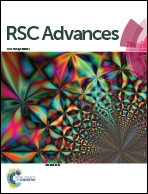Laser irradiation durability of photorefractive ferroelectric liquid crystal blends containing terthiophene photoconductive chiral dopants†
Abstract
Ferroelectric liquid crystal blends composed of a smectic liquid crystalline mixture, a photoconductive chiral dopant, and an electron trap reagent exhibit significant photorefractivity together with rapid responses. As such, they allow the dynamic amplification of moving optical signals. In the present work, the photochemical durability of a photorefractive ferroelectric liquid crystal blend sandwiched between two transparent electrodes was investigated. A series of photoconductive chiral dopants was prepared and the durability of blends incorporating these dopants during laser irradiation was examined. The photorefractivity of the liquid crystal blend with application of a DC electric field was found to decay on increasing the laser irradiation time. However, no evidence for a photochemical reaction of the photoconductive chiral dopant was obtained. The effect of the conduction of photogenerated ionic species on the photorefractivity decay was clarified. It was concluded that the observed decay of the photorefractivity was caused by the adsorption of photogenerated ionic species on the electrode.


 Please wait while we load your content...
Please wait while we load your content...